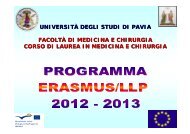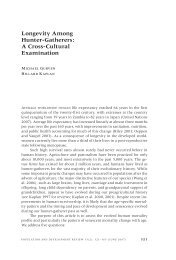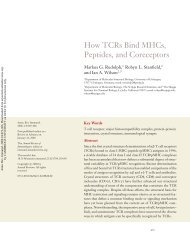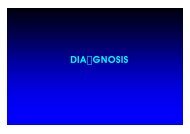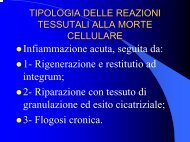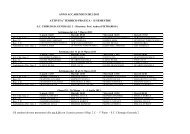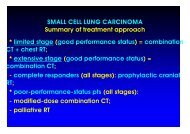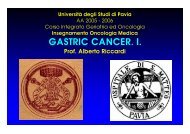Download
Download
Download
Create successful ePaper yourself
Turn your PDF publications into a flip-book with our unique Google optimized e-Paper software.
Syndromes
Trisomy 21<br />
Down Syndrome
• Characteristic<br />
facial features:<br />
–Upward‐slanting<br />
palpebral<br />
fissures<br />
–Epicanthal folds<br />
–Flat nasal bridge
Brushfield spots
• Bridged palmar<br />
crease: two<br />
transverse palmar<br />
creases are<br />
connected by a<br />
diagonal line<br />
• Wide space between<br />
first and second toes<br />
• Short fifth finger
• Small ears<br />
• Flat occiput
Trisomy 21: Physical Findings<br />
• Hypotonia<br />
• Small head<br />
• Epicanthal folds<br />
• Flat nasal bridge<br />
• Upward slanting<br />
palpebral fissures<br />
• Brushfield spots<br />
• Small mouth and ears<br />
• Extra skin at the nape<br />
of neck<br />
• Single transverse<br />
palmar crease<br />
• 5th finger clinodactylyl<br />
• Sandal toe gap
Trisomy 21: Associated defects<br />
• Congenital heart defects<br />
• Mental retardation<br />
• Leukemia<br />
• Hearing loss, otitis media<br />
• Hirschsprung disease, duodenal<br />
atresia<br />
• Cataracts<br />
• Thyroid disease<br />
• Hip dislocation<br />
• Atlantoaxial instability/dislocation
Down syndrome<br />
• 1 in 700 live births<br />
• >60% spontaneously aborted<br />
• 20% stillborn<br />
• Facial appearance permits diagnosis<br />
• Marked muscle hypotonia as baby<br />
• Learning difficulty (IQ usually
Three different patterns of chromosomes can cause Down syndrome<br />
Non‐disjunction<br />
Non‐disjunction<br />
• 95% people have three separate copies of<br />
chromosome 21 ‐ trisomy 21 –non disjunction<br />
•4% have the extra copy of chromosome<br />
21 because of a Robertsonian translocation<br />
•1% have mosaicism with normal and<br />
trisomy 21 cell lines (and usually have much<br />
milder features because of the presence of<br />
the normal cells); ‐ occurs postzygotically
Meiotic<br />
Non‐disjunction<br />
(Trisomy 21:<br />
75% meiosis 1)<br />
Trisomy Monosomy (lethal)
Trisomy 21: 47,XX,+21<br />
three separate copies of chromosome 21
Interphase FISH test for trisomy 21<br />
The chromosome 21 probe is labelled with a red fluorochrome and a control probe (for<br />
chromosome 18) is labelled in green. The two green dots show that the hybridization<br />
has worked for this cell, and the three red dots show that there are three copies of<br />
chromosome 21. The clinical report is based on examining a large number of cells. For<br />
prenatal diagnosis a mix of differently coloured probes from chromosomes 13, 18, 21, X<br />
and Y is often used.
Incidence of trisomy 21 at the time of chorionic villus sampling (10‐11 weeks), amniocentesis (16 weeks) and term.<br />
The incidence of trisomy 21 increases with increasing maternal age.
Trisomy 21 amniocyte
The trisomy 21 type of Down<br />
syndrome is the result of an error in<br />
meiosis, and has a recurrence risk of<br />
about 1 in 100.
Neonatal features<br />
• Flat facial profile<br />
• Poor Moro reflex<br />
• Excessive skin at the<br />
nape of neck<br />
• Slanted palpebral<br />
fissures<br />
• Hypotonia<br />
• Hyper flexibility of<br />
joints<br />
• Dysplasia of pelvis<br />
• Anomalous ears<br />
• Dysplasia of<br />
midphalanx of fifth<br />
finger<br />
• Transverse palmer<br />
crease
Mental Retardation<br />
• Almost all DS babies have MR.<br />
• Mildly to moderately retarded .<br />
• Starts in the first year of life.<br />
• Average age of sitting (11 mon), and walking (26<br />
mon) is twice the typical age.<br />
• First words at 18 months.<br />
• IQ declines through the first 10 years of age,<br />
reaching a plateau in adolescence that continues<br />
into adulthood.
Heart Disease<br />
• 50 % of Down Syndrome pts have heart disease<br />
• Atrioventricular septal defect<br />
• VSD / ASD<br />
• PDA<br />
• Tetralogy of Fallot<br />
• Mitral valve prolapse<br />
• Note: all the anomalies are the common<br />
malformations observed in the population, none<br />
of them is observed exclusively in DS
GI abnormalities<br />
• 5% of cases<br />
• Duodenal atresia or stenosis, sometimes<br />
association with annular pancreas in 2.5 % of<br />
cases<br />
• Imperforate anus<br />
• Esophageal atresia with TE fistula is less<br />
common<br />
• Hirschsprung’s disease<br />
• Strong association with celiac disease 5 –16 % ,<br />
5 –16 fold increase as compared to general<br />
population
Growth<br />
• BW, length and HC are less in DS<br />
• Reduced growth rate<br />
• Prevalence of obesity is greater in DS<br />
• Weight is less than expected for length in<br />
infants with DS, and then increases<br />
disproportionally so that they are obese by<br />
age 3‐4 yrs
Eye problems<br />
Most common disorders are<br />
Refractory error –35 to 76 percent<br />
Strabismus –25 to 57 percent<br />
Nystagmus –18 to 22 percent<br />
Cataract occur in 5 % of newborns.<br />
Frequency increases with age.
Hematologic disorders<br />
• The risk of leukemia is 1 to 1.5 percent.<br />
• 65% of newborn have polycythemia resulting in<br />
hypoglycemia.<br />
• Risk of AML and ALL is also much higher than the<br />
general population.<br />
• Transient leukemia – exclusively affects NB.<br />
‐ It is asymptomatic with spontaneous resolution in 2‐<br />
3 months.<br />
‐ Vesiculopustular skin eruptions are common and<br />
resolve with disorder.
Hearing loss<br />
• Unilateral or bilateral<br />
• Conductive, sensorineural or mixed<br />
• Otitis media is a frequent problem
Endocrine disorder<br />
• Thyroid disease – Hypothyroidism occurs<br />
more frequently than hyperthyroidism.<br />
• Diabetes –The risk of type 1 diabetes is<br />
three times greater than that of the<br />
general population.
Mortality<br />
Median age of death has increased from 25 yrs<br />
in 1983 to 49 yrs in 1997, an average of 1.7 yrs<br />
increase per year.<br />
Most likely cause of death is CHD, Dementia,<br />
Hypothyroidism and Leukemia.<br />
Improved survival is because of increased<br />
placements of infants in homes and<br />
changes in treatment for common causes of<br />
death.
REPRODUCTION<br />
Women with DS are fertile and may<br />
become pregnant.
REPRODUCTION<br />
Nearly all males with DS are infertile.<br />
The mechanism is impairment of<br />
spermatogenesis
Down’s Syndrome
Analyzing the origin of extra chromosome 21<br />
?<br />
p1 p4<br />
p3 p2
Patau Syndrome<br />
A picture demonstrating<br />
polydactyly, or extra fingers,<br />
a common abnormality in<br />
Patau syndrome.
Description<br />
•Patau syndrome ‐ also known as trisomy 13<br />
and trisomy D.<br />
•Affects about 1 in 12,000 live births.<br />
•More than 80% of infants with Patau<br />
syndrome die within their first year of life.<br />
The Simian line, or an<br />
abnormal palm pattern that<br />
is usually a symptom of<br />
Patau syndrome.<br />
Cayden Phipps: 3A ‐ Abrams 36
History<br />
Patau syndrome, or “Trisomy 13”, as it was first<br />
called, was first observed by Thomas Bartholin in<br />
1657. However, the actual genetic and<br />
chromosomal‐related parts of it were discovered<br />
by Dr. Klaus Patau in 1960, hence the name<br />
“Patau syndrome”.<br />
Cayden Phipps: 3A ‐ Abrams 37
Trisomy 13
Common Problems cont.<br />
Muscular and skin problems:<br />
• Polydactyly, or extra fingers/toes<br />
• Low‐down ears<br />
• Prominent heels and deformed feet, called ‘rocker‐bottom’ feet<br />
• Strange palm patterns, commonly called the Simian line<br />
• Overlapping of the fingers over thumb<br />
• Cleft palate<br />
Polydactyly The Simian line ‘Rocker-bottom’ feet<br />
Cayden Phipps: 3A ‐ Abrams 40
Common Problems, cont.<br />
Vascular Problems:<br />
• Kidney problems<br />
• Heart defects such as ventricular septal defect<br />
Kidney Problem<br />
The disease shown<br />
right is called<br />
Polycystic kidney<br />
disease (PKD).<br />
This is a disorder in<br />
which clumps of cysts<br />
develop within your<br />
kidneys. Cysts are<br />
small round sacs<br />
containing water-like<br />
fluid.<br />
Cayden Phipps: 3A ‐ Abrams 41
Common Problems<br />
Nervous system problems:<br />
• Mental and motor disabilities<br />
• Microcephaly, or a less rounded brain resulting in more of an<br />
egg‐shaped skull<br />
• Eye structure defects:<br />
• Microphthalmia, or crossed eyes (may involve one eye or both)<br />
• Cataracts<br />
• Sensory Nystagmus, or involuntart “twitching” of the eye<br />
• Optic nerve hypoplasia, or the underdevelopment of the optic<br />
nerve<br />
S<br />
Cayden Phipps: 3A ‐ Abrams 42
Treatment<br />
• There is no treatment to address the condition.<br />
However, there are procedures to sustain life for a<br />
bit.<br />
• Most times, surgery is required to fix defects to<br />
allow the child to survive for as long as possible.<br />
• Most infants with Patau syndrome die within the<br />
first year of life, but many children have trouble<br />
surviving the first few days or weeks of life due to<br />
severe neurologic and vascular problems.<br />
43
Mosaic Patau<br />
A small percentage of cases occur when only<br />
some of the body’s cells have an extra copy of<br />
chromosome 13, resulting in a mixed population<br />
of cells with differing numbers of chromosomes.<br />
This is called Mosaic Patau.<br />
A baby with a cleft palate, a<br />
common abnormality of Patau<br />
syndrome.<br />
Cayden Phipps: 3A ‐ Abrams<br />
44
Edwards Syndrome-<br />
Trisomy 18<br />
is a rare genetic disorder<br />
caused by an extra copy of<br />
chromosome18.
Trisomy 18 (Edward)<br />
• Incidence 1:4000 live births<br />
• Males : females 1:3<br />
• 5‐10% survive first year<br />
• Death usually due to heart failure or<br />
pneumonia
• L<br />
• O<br />
• L<br />
• S S<br />
• C<br />
• U<br />
• F<br />
• G<br />
• S<br />
• H
•Meckel’s diverticulum, horseshoe<br />
kidneys<br />
• Dorsiflexed short hallux<br />
•Short sternum, mental retardation
• Prominent occiput and low‐set, posteriorly<br />
rotated malformed auricles<br />
• Clenched hand showing typical pattern of<br />
overlapping fingers<br />
• Rocker‐bottom feet
Imprinting: Definition and historical<br />
perspectives<br />
• Imprinting: an epigenetic modification to<br />
DNA that results in “memory of parental<br />
origin”<br />
• By convention, the inactive allele is said to<br />
be “imprinted”<br />
• Early evidence:<br />
– early embryo nuclear transfer experiments<br />
– gynogenetic and androgenetic embryos fail to<br />
survive
Imprinting: Mechanisms and purpose<br />
• Epigenetic modification that is<br />
reversible in germ line<br />
• DNA methylation and chromatin<br />
configuration are important<br />
• Imprinting may be a reflection of<br />
“parental conflict:”<br />
– paternal gene for rapid growth<br />
– maternal genes for growth retardation to<br />
maximize litter size
Experimental and clinical evidence for<br />
imprinting<br />
• Mouse embryology ‐ opposite phenotypes<br />
in cases of uniparental disomy<br />
• Human imprinting syndromes:<br />
– Prader‐Willi syndrome (inheritance of paternal<br />
deletion ‐‐‐> maternal monosomy)<br />
– Angelman syndrome (inheritance of maternal<br />
deletion ‐‐‐> paternal monosomy)<br />
– Beckwith‐Wiedemann syndrome ‐ paternal<br />
disomy
Map of Imprinted<br />
Regions in Human<br />
Genome<br />
Maternally inherited<br />
homolog (left)<br />
Paternally inherited<br />
homolog (right)
Genomic Imprinting
Angelman<br />
• Seizures<br />
• Jerky, ataxic movements<br />
• Abnormal facies<br />
• Chromosome 15 deletion with maternal<br />
imprinting
• Maxillary hypoplasia<br />
• Large mouth<br />
• Prognathism
• Low tone<br />
• Large appetite—<br />
obesity<br />
• Hypogonadism<br />
• Developmental<br />
delay/MR<br />
• Chromosome 15<br />
deletion, paternal<br />
imprinting<br />
Prader‐Willi
• Marked obesity<br />
• Excess fat over the<br />
trunk, buttocks, and<br />
proximal extremities<br />
• Small hands (and<br />
feet)<br />
• Hypoplastic penis and<br />
scrotum



